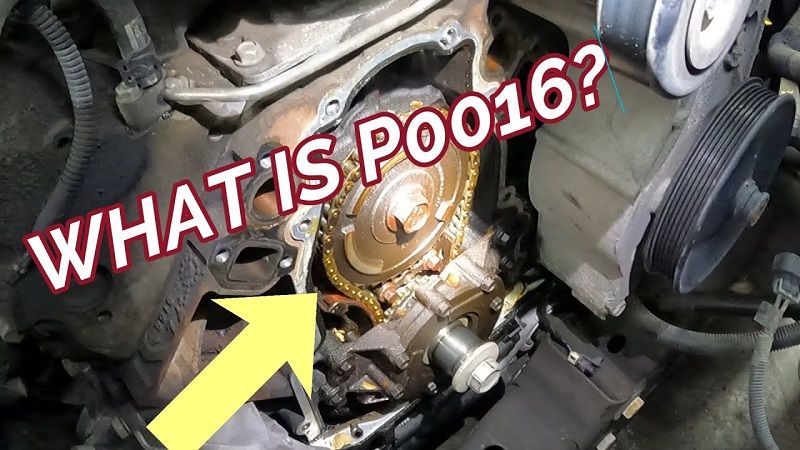This post contains affiliate links. This means I will make a commission at no extra cost to you should you click through and make a purchase [ “As an Amazon Associate, I earn from qualifying purchases.” ]. Read the full disclosure here.
Understanding the P0016 Code: Crankshaft Position – Camshaft Position Correlation (Bank 1 Sensor A) GuideMechanic.Com In the realm of automotive diagnostics, the appearance of a fault code can often set off alarm bells for vehicle owners and technicians alike.
One such code that frequently raises concern is the P0016 code, signaling a potential issue with the correlation between the crankshaft position and the camshaft position in Bank 1 Sensor A of the engine.
Understanding what this code means, its potential causes, and the necessary steps for diagnosis and repair is crucial for ensuring the continued performance and reliability of the vehicle.
See Also: P0014 Code “B” Camshaft Position – Timing Over-Advanced or System Performance (Bank 1)
What is the P0016 Code?

The P0016 code specifically points to a discrepancy between the timing of the crankshaft and camshaft in Bank 1 Sensor A of the engine.
In modern vehicles equipped with variable valve timing (VVT) systems, precise synchronization between these components is essential for optimal engine performance, fuel efficiency, and emissions control.
When the Engine Control Module (ECM) detects a deviation beyond acceptable limits in the timing correlation between the crankshaft and camshaft, it triggers the P0016 code and illuminates the check engine light on the dashboard.
Causes of Code:
Check out this Cloyes C-3220 Timing Chain Kit

Faulty Camshaft or Crankshaft Position Sensor:
A malfunctioning sensor can provide inaccurate data to the ECM, leading to timing discrepancies.
Timing Chain/Belt Issues:
Worn or stretched timing chains or belts can cause slack, affecting the timing between the crankshaft and camshaft.
VVT Solenoid Malfunction:
The Variable Valve Timing (VVT) solenoid controls oil flow to adjust camshaft timing. If it fails or becomes clogged with debris, timing issues may arise.
Engine Oil Issues:
Insufficient oil pressure or dirty engine oil can hinder the operation of VVT components, impacting timing synchronization.
Mechanical Engine Problems:
Damage to components such as the timing chain guides, tensioners, or gears can disrupt the timing relationship between the crankshaft and camshaft.
ECM Malfunction:
In rare cases, a faulty ECM may erroneously interpret sensor data, leading to incorrect timing adjustments.
P0016 Code: Camshaft Position Correlation (Bank 1 Sensor A)

Diagnosis and Repair:
Diagnosing the root cause of a P0016 code typically involves a systematic approach by a qualified technician:
Code Retrieval:
Using a diagnostic scan tool, retrieve the trouble codes stored in the ECM, paying specific attention to any additional codes that may provide further insight.
Visual Inspection:
Visually inspect the engine components, focusing on the timing chain/belt, sensors, and VVT solenoid for signs of wear, damage, or oil leaks.
Sensor Testing:
Test the camshaft and crankshaft position sensors using a multimeter to ensure they are functioning within specifications.
Oil Pressure Check:
Verify adequate engine oil pressure using a mechanical gauge, addressing any issues with oil level or viscosity.
Timing Components Inspection:
If necessary, remove components such as the timing cover to inspect the timing chain, tensioners, and guides for wear or damage.
VVT System Testing:
Test the VVT solenoid for proper operation and check for obstructions in the oil passages.
ECM Scan:
Perform a thorough scan of the ECM for any potential software-related issues or updates that may address the problem.
P0016 Code: Camshaft Position Correlation (Bank 1 Sensor A)
Once the underlying issue has been identified, repairs can commence:
Sensor Replacement:

Replace any faulty camshaft or crankshaft position sensors and ensure proper installation and calibration.
Timing Chain/Belt Replacement:
If timing components are worn or damaged, replace them following manufacturer specifications.
VVT Solenoid Replacement:
Replace the VVT solenoid if deemed faulty, ensuring proper oil flow and function.
Oil Change and Maintenance:
Perform an oil change using the manufacturer’s recommended oil grade and viscosity, addressing any oil-related issues.
ECM Replacement/Reprogramming:
If necessary, replace or reprogram the ECM to correct any software-related issues.
Conclusion:
See Also: P0015 Code “B” Camshaft Position -Timing Over-Retarded (Bank 1)
The appearance of a P0016 code indicating a crankshaft position – camshaft position correlation issue demands prompt attention to prevent potential engine damage and performance degradation.
Understanding the underlying causes and following a systematic diagnostic approach is essential for accurate diagnosis and effective repairs.
By addressing the root cause of the problem, vehicle owners can ensure their vehicle’s continued reliability and performance on the road.
Regular maintenance, including oil changes and inspections, can also help prevent such issues from occurring in the future, ultimately extending the lifespan of the engine and drivetrain components.
- P008C Fuel Cooler Pump Control Circuit Open - November 4, 2024
- P008D Fuel Cooler Pump Control Circuit Low - October 30, 2024
- P008E Fuel Cooler Pump Control Circuit High - October 26, 2024
